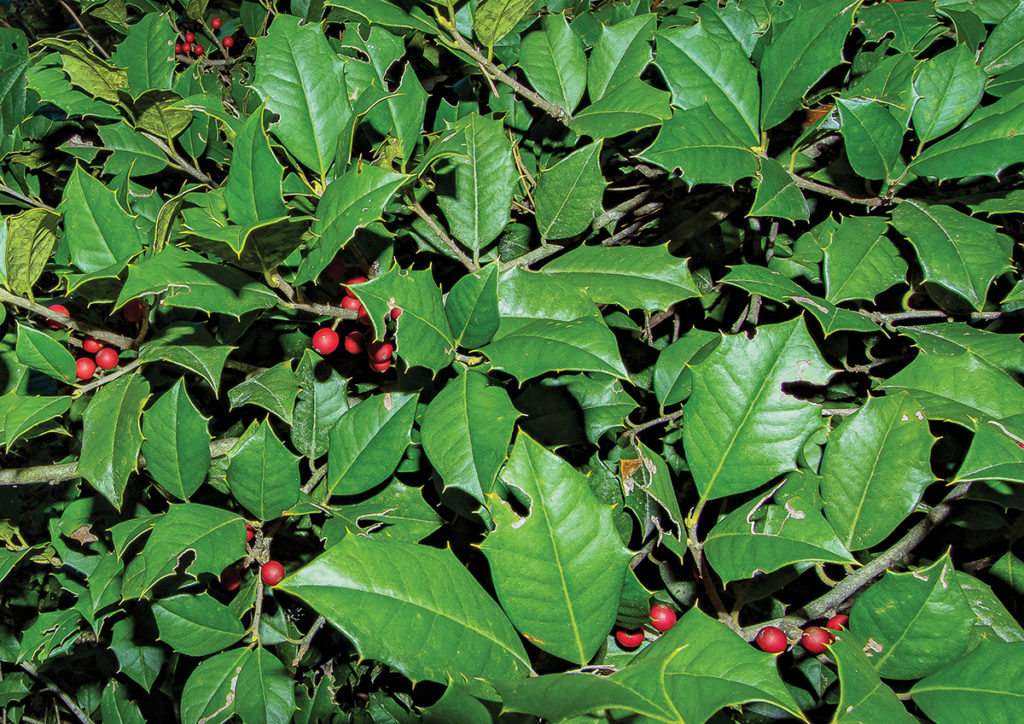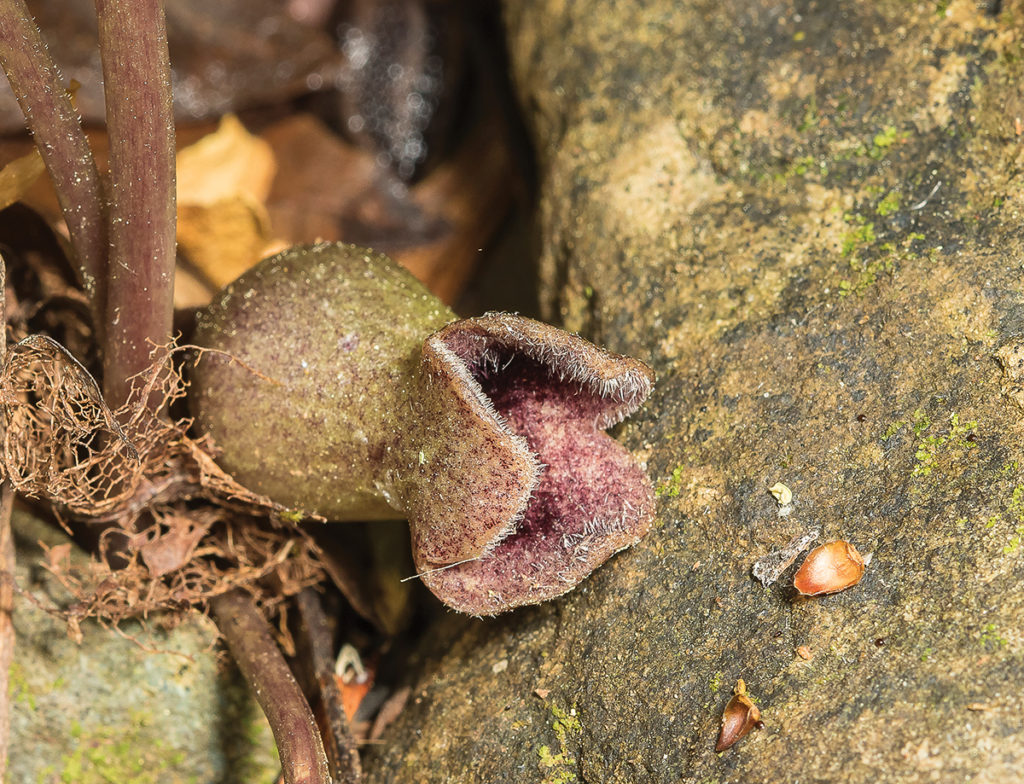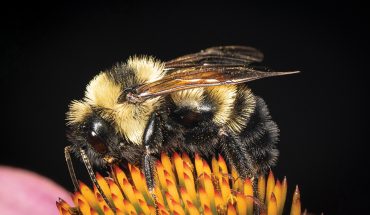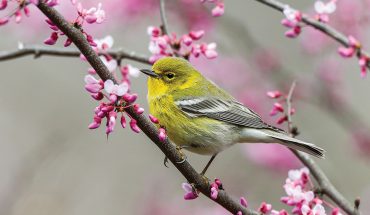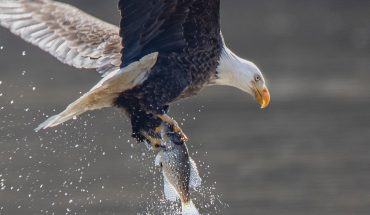In this season of bare branches, discovering a green leaf or red berry is a delightful surprise — and a sign that spring isn’t far away.
Words and photographs by Mike Dunn
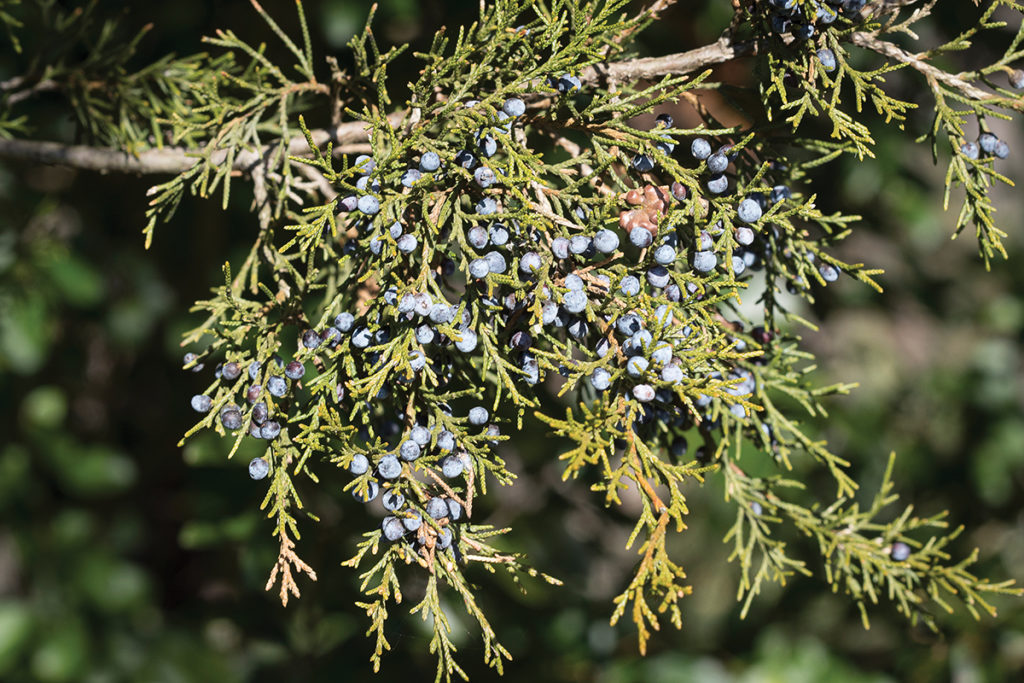
In these few months without as much color, I appreciate the earth tones and textures of the winter woods. In fact, that’s one of the things I love about this area: there are four distinct seasons, each with its own unique beauty. And yet seeing a hint of green amid the mostly brown and gray forest is a nice surprise on a cold morning walk.
When we think of green plants in winter, the word “evergreen” comes to mind — usually meaning those trees that don’t lose their leaves in winter, like our deciduous trees do. The dominant evergreen tree in this area is the Loblolly Pine. I love seeing our pines in winter snow, the way their needles droop under the weight of the white blanket.
In our backyard woods we have a few pines, but the most common evergreen is the American Holly, best known for its spiny leaves and beautiful red berries in winter. Branches are often collected this time of year as Christmas decorations. Unlike many trees, male and female holly flowers appear on separate trees, so only female trees produce berries. The fruit is a valuable late-winter food source for many birds, including American Robins, Cedar Waxwings, Hermit Thrushes and Eastern Bluebirds (though humans should not eat the berries).
The dense evergreen foliage also provides important shelter for birds. Every year I find Northern Cardinal nests in our hollies, hidden away from the prying eyes of nest-robbing crows and jays. One winter day, I watched as a Sharp-shinned Hawk dove at some birds at our feeder; they escaped into a nearby holly. The hawk kept chasing the small birds around the densely packed branches until it gave up and flew off. Yet another attribute benefits us more than the birds: The wood is fine-grained and white, making it a great choice for carvings and other woodwork.
If I had walked our land 75 to 100 years ago, there would have been another species as the dominant evergreen, Eastern Red Cedar. We still have some large cedars and a few saplings along the sunny roadsides, but now our woods are dotted with the sun-bleached skeletons of those of the past. This hints that our land was once cleared and probably used for pasture and crops.
Red Cedar grows best in open landscapes, where its bluish berries and dense foliage mimic the wildlife values of holly. Squirrels will often use strips of cedar bark in their nests, and the stringy fibers make a great firestarter. We have several dozen fence posts, a cedar chest and some tables and benches made from the beautiful and rot-resistant wood.
A walk in the winter woods may also provide some patches of ground-level greens. Clumps of Christmas Ferns adorn much of our land, one of the few ferns in our area that remain green all year. I learned a tip years ago to help me identify this common species: A close look at the leaflets shows a noticeable bump at one end. When viewed sideways, the leaflet is said to resemble Santa’s sleigh. When held vertically, by the tip, it looks like a tiny stocking you might see on an elf’s mantel. New fern fronds start growing by late winter and the fiddleheads are often topped in snow.
One of my favorite woodland evergreens goes by several common names: Wild Ginger, Heartleaf and Little Brown Jug. I first learned it as Wild Ginger because a crushed leaf is aromatic, smelling like ginger to some or maybe even licorice (but don’t eat this, either). That name can cause some confusion with another Wild Ginger in our mountains that has deciduous leaves. Heartleaf is apt because of the shape of the thick, mottled leaves. But I prefer Little Brown Jug, named for its unusual jug-shaped flowers, which are generally hidden under leaf litter at the base of the plant in spring.
It requires a close look to find the diminutive creeping plant, Partridgeberry. The bright red berry is often the easiest way to spot the plant nestled amongst the dried leaves on the forest floor. In summer, look for a small pair of white flowers joined at their base. The two flowers produce one fruit.
Look for Striped Wintergreen on your next walk — its genus name, Chimaphila, is Greek for “loves winter.” The dark green leaves have white stripes along their length. It and a close relative also go by the common name Pipsissewa, a Native American word meaning “to break into small pieces.” This refers to the use of compounds in both plants to treat urinary tract infections and kidney stones.
One of the more unusual green plants you may see this winter is the single leaf of a Cranefly Orchid. This plant sends up a leaf in the fall that persists through the winter. The leaf dies back in the spring, so by late summer, when the slender flower stalk appears, the leaf is already gone. Its scientific name, Tipularia discolor, refers to the two colors of the leaf: green on top and purple underneath.
No one is sure why this color disparity exists. One theory is that the dark purple underside helps absorb light that’s reflected off the forest floor, thus maximizing the low angle winter light; another is that it acts more like a sunscreen to help protect the plant’s photosynthetic machinery. (Fun fact: the leaf is called a hibernal leaf because it is present only during the winter when many other plants are dormant.)
A similar strategy in terms of leaf timing is employed by a less common orchid, Putty-root. Its pin-striped leaf appears in fall and disappears before the flowers in spring. Settlers used a gooey substance obtained from the corms (part of its underground food storage system) to glaze windows and repair pottery, hence the common name. The corms are paired, which gives rise to another common name, Adam and Eve Root.
Why do these plants stay green when most of our flora shed their leaves and go dormant during the coldest months? The ability to photosynthesize during winter has obvious advantages, especially for ground-dwelling species that may get little light in the shade of a leafy summer forest.
But they also must avoid the hazards of severe cold and lack of water that can occur in winter, so many have adaptations like waxy coatings, thicker leaves or a low-profile growth form, each of which may help shield them from drying winds and provide some warmth from the sun hitting the forest floor.
And for those of us that love a walk in the winter woods, the splash of color that helps us remember that the greens of spring are not far away.
This article originally appeared in the December 2022 issue of WALTER magazine.


